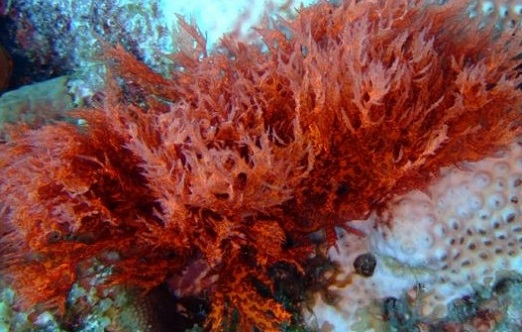U.S. NIH Study Finds That Algal Lectin Griffithsin Shows Promise in Preventing Ebola Virus Infection
Nikhil Prasad Fact checked by:Thailand Medical News Team Feb 16, 2025 1 month, 3 weeks, 4 days, 5 hours, 42 minutes ago
Medical News: A Natural Compound That Could Help Combat Deadly Ebola Outbreaks
A recent study has uncovered a natural compound that could play a role in fighting the deadly Ebola virus. Researchers from the University of Nebraska-Lincoln-USA, Texas Biomedical Research Institute0USA, and the U.S. National Institute of Allergy and Infectious Diseases have found that Griffithsin, a protein derived from red algae, has strong antiviral effects against the Ebola virus. Their findings suggest that this naturally occurring compound could be developed into a potential treatment for Ebola virus disease (EVD), which has caused numerous deadly outbreaks in Africa.
 Griffithsin, a Lectin frm the Red Algae Shows Promise in Preventing Ebola Virus Infection
Griffithsin, a Lectin frm the Red Algae Shows Promise in Preventing Ebola Virus Infection
Ebola virus is highly lethal, with a mortality rate of about 50%. While there are vaccines and antibody-based drugs available, treatment options remain limited. This
Medical News report highlights how Griffithsin (GRFT) could provide a new approach to combating this life-threatening virus. The study tested GRFT’s ability to block the Ebola virus both in laboratory experiments and in live animal models, with promising results.
How Griffithsin Works Against Ebola
Griffithsin is known for its ability to bind to specific sugars found on the surface of viruses. It has already been studied for its effects against other dangerous viruses, including HIV, hepatitis C, and coronaviruses. In this study, researchers found that GRFT binds to the outer layer of the Ebola virus, preventing it from entering human cells and spreading infection.
The laboratory tests showed that GRFT was highly effective in blocking Ebola virus infection. The researchers used a special virus model to mimic the behavior of the actual Ebola virus. They discovered that GRFT could inhibit infection at very low concentrations, with an IC50 value of around 42 nanomolar (nM). This means that even in small amounts, the compound was able to significantly reduce the virus’s ability to infect cells.
Further testing in a high-security laboratory confirmed these results. When GRFT was tested against the live, wild-type Zaire Ebola virus (the most deadly strain), it demonstrated similar potency. These findings indicate that Griffithsin has strong antiviral activity and could be a useful tool in preventing the spread of Ebola.
Testing in Mice Shows Encouraging Results
To evaluate whether Griffithsin could help protect living organisms from Ebola, researchers conducted experiments using a mouse model. The mice were infected with a strain of Ebola adapted to their system, and some were treated with GRFT injections. The results showed that while all untreated mice died within six days, those that received GRFT treatment survived slightly longer, with some living up to seven days.
Although the increase in survival time was small, it suggests that GRFT has some protective effects against Ebola infection. The researchers noted that further studies are needed to refine the tr
eatment, possibly by combining it with other antiviral drugs to enhance its effectiveness. The fact that GRFT showed some benefit even at a low dose is an encouraging sign for future research.
Griffithsin’s Unique Binding Ability
One of the key reasons Griffithsin is so effective is its ability to bind to glycans (sugar molecules) found on the surface of many viruses. Ebola virus has a protein on its outer layer called glycoprotein, which is heavily covered with these sugar molecules. The study showed that GRFT attaches to these glycans, blocking the virus from entering human cells.
To confirm this, researchers conducted a specialized test where they removed the sugar molecules from the virus and observed whether GRFT could still bind to it. The results were clear: when the glycans were removed, GRFT no longer attached to the virus. This proved that Griffithsin specifically targets the sugar-coated layer of Ebola, preventing infection by disrupting the virus’s ability to attach to and invade human cells.
Potential for Future Treatments
Griffithsin has been studied for years as a potential antiviral treatment. It has already been tested in clinical trials for its effectiveness against HIV and has shown promise in treating other viral infections. One of its key advantages is that it does not appear to cause strong immune reactions in the body, making it a safer option for therapeutic use.
The researchers believe that with further development, GRFT could be used either as a standalone treatment or in combination with other drugs to improve its effectiveness. For example, pairing GRFT with an antiviral like Remdesivir, which targets the virus’s ability to replicate, could create a powerful treatment approach. The fact that Griffithsin can be produced in plants or in laboratory systems also makes it a cost-effective candidate for mass production.
Additionally, scientists are exploring other naturally occurring proteins similar to Griffithsin to see if they might also have antiviral properties. Some of these proteins have been found in plants like bananas, rice, and barley, indicating that nature may hold even more potential solutions to viral infections.
Conclusion
The study provides strong evidence that Griffithsin is a promising candidate for treating Ebola virus infection. By binding to the virus’s sugar-coated surface, GRFT effectively blocks its ability to infect human cells. While early results in mice suggest only modest benefits, the compound’s effectiveness in laboratory tests and its known safety profile make it a strong contender for further research.
With the constant threat of Ebola outbreaks, finding new treatment options is crucial. Griffithsin’s broad-spectrum antiviral activity and natural origin make it a unique and exciting prospect for future drug development. Researchers hope that with additional studies and optimization, GRFT-based therapies could one day provide an effective tool in the fight against Ebola.
The study findings were published in the peer-reviewed journal: Molecules.
https://www.mdpi.com/1420-3049/30/4/892
For the latest on Ebola, keep on logging to Thailand
Medical News.
Read Also:
https://www.thailandmedical.news/news/herbs-and-phytochemicals-griffithsin-a-lectin-derived-from-the-red-algae-is-able-to-inhibit-influenza-a-and-sars-cov-2-viruses
https://www.thailandmedical.news/news/covid-19-news-californian-study-shows-that-antiviral-activity-of-the-lectin-griffithsin-against-sars-cov-2-is-enhanced-by-presence-of-membrane-protein
https://www.thailandmedical.news/news/breaking-french-study-shows-that-mannose-specific-lectins-from-plants,-fungi,-algae-and-cyanobacteria-can-prevent-various-coronavirus-transmissions-in
https://www.thailandmedical.news/news/phytochemicals-from-marine-algae-offer-hope-in-combating-hmpv-infections
https://www.thailandmedical.news/news/breakthrough-in-anti-herpes-treatment-thailand-medical-researchers-at-chiang-mai-university-discover-potent-algae-extract
